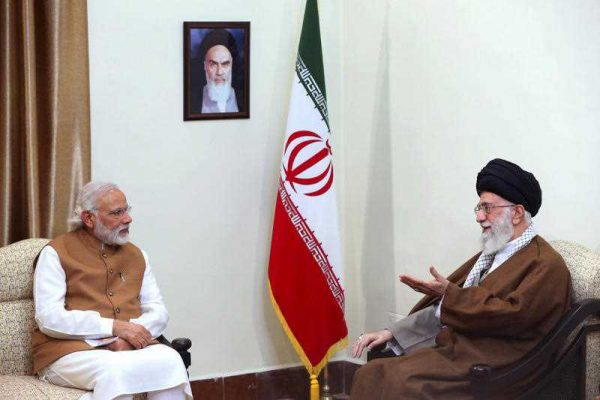During the previous government’s term, India–Iran ties had been in turmoil. New Delhi voted against Tehran twice in the UN Security Council and lowered oil imports in line with economic sanctions imposed by Western countries. When the Modi government came to power, India decided to change its policy towards Iran.
The first sign of this appeared when Prime Minister Modi met Iranian President Hassan Rouhani on the sidelines of the July 2015 Shanghai Cooperation Organisation and BRICS summits in Russia. The removal of economic sanctions, following a nuclear deal between Iran and the P5+1 (the United States, the United Kingdom, France, Russia, China and Germany) further freed India to improve its ties with Iran. Soon after, India’s National Security Adviser Ajit Doval, Transport Minister Nitin Gadkari, Natural Gas and Petroleum Minister Dharmendra Pradhan and External Affairs Minister Sushma Swaraj visited Iran — laying the foundation for the successful visit of Prime Minister Modi.
One of the most important aspects of Modi’s visit was his meeting with the reclusive Iranian Supreme Leader, Grand Ayatollah Sayyid Ali Hosseini Khamenei. The Ayatollah rarely holds meetings with visiting world leaders. The meeting has underscored the high importance that Iran’s government and its supreme religious leader accord to India.
Another noteworthy aspect was Modi’s announcement that India would invest approximately US$500 million building the Chabahar Port. This is of strategic significance for India as it competes with China, which is building the Gwadar Port in Pakistan, just over 100 kilometres from Chabahar. The port will also provide India trade routes to Afghanistan, Central Asia and beyond.
Along with the development of the Chabahar Port, the signing of the trilateral agreement to build a transit and transport corridor between India, Iran and Afghanistan has given a clear indication that these three countries are focused on deepening regional connectivity, neutralising Pakistan’s importance as a transit route between India, Afghanistan, Central Asia and Europe. It can also be viewed as a response to the development of the China–Pakistan Economic Corridor.
This transit and transport corridor will play a major role in ensuring the economic development, peace and security of Afghanistan after the withdrawal of NATO forces. It will be further boosted by the India-backed International North–South Transport Corridor project, aimed at connecting the regional countries of South, Central and West Asia with Russia and Europe — enabling India to compete with China’s One Belt, One Road project. The Chabahar Port will make Iran an international trade conduit for landlocked Central Asian countries and Afghanistan. This, in turn, will aid Iran’s economically backward providences of Sistan and Baluchestan, where this port is located. The strategic significance of the port will further enhance Iran’s position in this region.
Improved ties between New Delhi and Tehran are needed to meet India’s energy demand. With the US-led economic sanctions on Iran being lifted, New Delhi wants to secure increased access to Iranian oil and petroleum products. This will also reduce India’s dependence on other oil exporting countries like Saudi Arabia.
India is aiming to develop the Farzad B gas field in the Persian Gulf. With these energy interests in mind, India has already paid US$750 million out of the US$6.5 billion owed to Iran for crude oil already imported. Iran has expressed its displeasure in the past over the issue of payments for oil imports.
Deepening ties with India in the energy sector is in Iran’s interests. Given India’s growing economy, convergences of security interests between New Delhi and Tehran as well as sour ties between Iran and European countries, Iran sees India as a viable and reliable destination for its oil exports.
India and Iran share deep concerns about the growth of terrorism in the region. More importantly, without naming Pakistan, the two countries voiced their disapproval of states that provide support and sanctuaries to terrorist groups, and expressed the view that states that aid, abet and directly or indirectly support terrorism should be condemned.
Prime Minister Modi has succeeded in infusing a new momentum into the relationship between India and Iran. At the same time, India and Iran should take concrete steps to foster cooperation in the defence area and facilitate the signing of a free trade agreement so that bilateral ties can be further expanded and deepened.
Sumit Kumar is a ICSSR Doctoral Fellow at the UGC Centre for Southern Asia Studies, Pondicherry University.


While this piece describes various ways in which the deepening and broadening of the bilateral relationship between India and Iran are beneficial, what are the potential drawbacks?
What will India’s stance be on Iran’s support for Hezbollah, for example?
How can/will India and Iran really help stabilize Afghanistan?